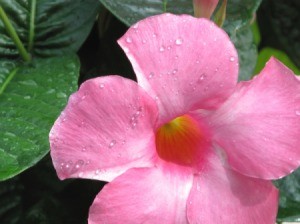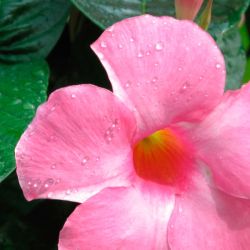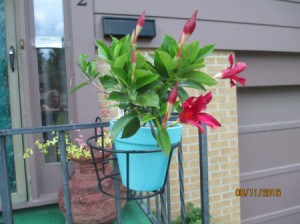
 The mandevilla is known for its showy flowers. There are about 100 species of this tropical American woody vine. The mandevilla produces a profusion of flowers, from spring until fall, ranging in color from white to pink or red, along its 15 - 20 foot vines. The flowers are unscented except as noted. Mandevilla is hardy in USDA zones 9 - 11, it will not tolerate temperatures lower than 45 degrees F. In all other areas it is grown as an annual or grown in a container so that it can be winterized.
The mandevilla is known for its showy flowers. There are about 100 species of this tropical American woody vine. The mandevilla produces a profusion of flowers, from spring until fall, ranging in color from white to pink or red, along its 15 - 20 foot vines. The flowers are unscented except as noted. Mandevilla is hardy in USDA zones 9 - 11, it will not tolerate temperatures lower than 45 degrees F. In all other areas it is grown as an annual or grown in a container so that it can be winterized.

The most common cultivar sold at nurseries is the Alice du Pont. The Mandeville laxa also known as the Chilean jasmine is a deciduous variety that is grown as an evergreen in frost free areas. It bears white flowers having a powerful fragrance similar to gardenia.
When growing your mandevilla outdoors, plant in a warm spot with good air circulation, in full sun or partial, dappled shade. Protect it from harsh midday sun. The ideal soil is loose and well drained containing lots of organic matter. Your mandevilla can be trellised or allowed to spread on the ground as a ground cover.
Mantevillas require regular watering to keep the soil evenly moist but not wet. Do not allow the soil to dry out. Feed your plant every other week during the spring and summer using a fertilizer high in phosphorus such as 10-20-10.
When your mandevilla is still young pinch back the vine at leaf axis, the point on the stem where the leaf buds out, to encourage more branching and a fuller plant. To keep your mandevilla looking its best, as it matures, prune out dead stems or vining stems that are rubbing against each other, as this can cause damage to the bark and make your plant more susceptible to disease.
The common garden pests that plague mandevilla vines, include scale insects, mealybugs, red spider mites, and whiteflies. Insect infested plants can be treated with a strong stream of water, insecticidal soaps, or an insecticide appropriate for this plant. Beneficial insects can also be introduced to help control the pests. Try ladybugs or lacewings.
Protecting Or Winterizing Your Mandevilla:
It is possible to allow your mandevilla to go dormant in a cool location, however there is no guarantee that it will reemerge in the spring. A better approach to growing mandevilla in zones lower than 9 is to plant it in a container and bring it inside for the winter. Mandevillas can be grown as houseplants or moved back and forth during the cold and warmer seasons. You can return it to the outdoors when temperatures average above 50 degrees and all danger of frost has passed.
Before moving your mandevilla indoors, inspect for pests and treat accordingly. Indoors, your mandevilla will need filtered light or indirect sunlight. Night time temperatures should be between 60 and 65, with daytime temperatures over 70. Prune your plant to an appropriate size for your home. It can be cut back by one half or more. Water it once a week, or as needed, to keep the soil slightly moist, not allowing it to dry out. Water until it runs out the bottom of the pot and discard the excess. In late winter or early spring prune to remove old or crowded stems. Your mandevilla will bloom in the summer on new growth. Two or three months before retuning your mandeville outdoors, begin fertilizing on a monthly cycle, using the 10-20-10 fertilizer.
If your chose to allow your mandevilla to go dormant, prune it back to between 8 and 12 inches. Place it in a dark space with a consistent temperature of between 50 and 60 degrees F. Keep the soil on the dry side by only watering approximately once a month. Bring it indoors in the spring and keep the soil moist. Move it outdoors once the temperature remains about 60F.
Source: Articles on SFGate website: Mandevilla and How to Winterize Mandevilla, Clemson University page on Mandevilla, and the The Sunset Western Garden Book.
Add your voice! Click below to comment. ThriftyFun is powered by your wisdom!
R B
Thanks for a great article. I grow and love Mandevillas. I wasn't aware of the scented Mandevilla laxa. You can be sure, I've already started looking. I will add this to my collection just as soon as I find a source.
Thanks, again
Doug
I have pretty red ones in a pot, brought it in last winter and put in the garage, put back out in the spring, took it awhile, but around last week of July fully bloomed.

I have a mandevilla that is very healthy but it has not produced any flowers. Any suggestions?
Add your voice! Click below to comment. ThriftyFun is powered by your wisdom!